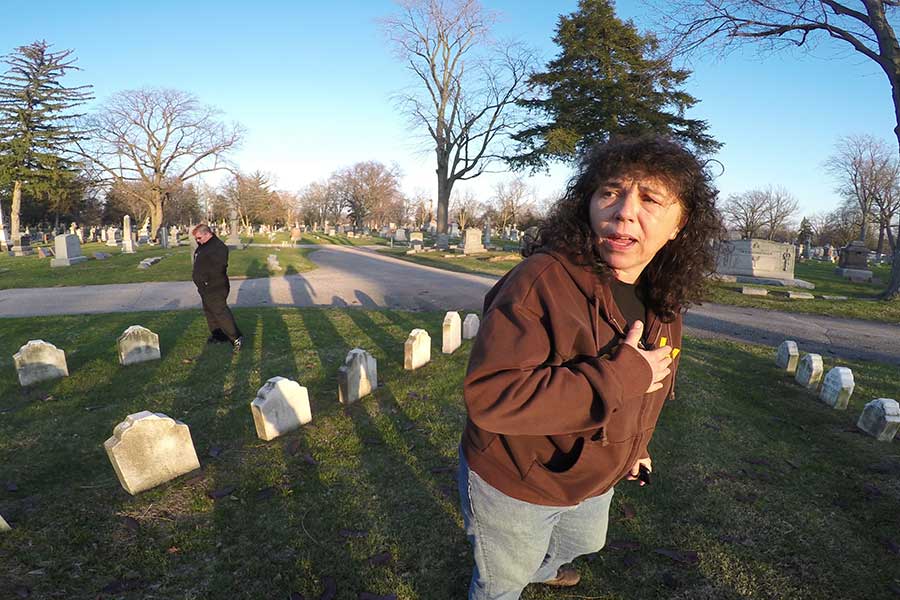Last December, seven LGBT people approached the cells that first housed inmates in 1889 at the Licking County Historic Jail in Newark, Ohio, about 40 miles east of Columbus. They hoped to find LGBT ghosts.
It had to happen at night — not for any creeping fear, but for the ghost hunters’ ability to tune their senses. There was no traffic and no light. They came prepared with dowsing rods to ask yes or no questions and recording equipment to capture “electronic voice phenomena,” called EVP, which are noted in paranormal circles as a way to hear spirits’ speech.
Scott Priddy had come across a flier for Queer Ghost Hunters around Halloween. He went to a meeting organized by Stonewall Columbus, the LGBT community center for central Ohio, and joined a small group that visited the jail.
“They called me ‘ghost bait,’” Priddy said. “I seem to attract the ghosts.”
In his first time ghost hunting, Priddy connected with a sheriff. He said he felt a strong tingling and buzzing. All the hair on his arms stood up. Others said the sheriff followed Priddy around and flirted with him.
“We all really cut our teeth on Licking County Jail,” said Lori Gum, the program and pride coordinator at Stonewall Columbus.
A series is born
From there, the team visited several other sites in Ohio, Kentucky and West Virginia.
Stu Maddux, the filmmaker behind LGBT documentaries like “Gen Silent,” followed the Queer Ghost Hunters for a web series of the same name. In time for the kickoff of LGBT History Month, the show debuted Oct. 1 with further episodes set for release every Friday on YouTube. The first season includes six episodes, each eight-10 minutes long. A Kickstarter campaign, at http://ow.ly/HmNe304Je6n, also launched this month to raise funds for a second season.
“We work really hard to balance the fun of the series and the thrill of the ghost hunt with the history,” Gum said. “That’s sort of our magic potion.”
Katy Detrow became the historian for the Queer Ghost Hunters, looking up records of LGBT people who lived and died in the places they investigate.
“Gay people have been around forever in all walks of life,” Priddy said. “I’m sure most people don’t think of a gay sheriff in the 1930s. Does anybody think of lesbian nuns? It’s a broad history.”
Gum and Maddux had been discussing LGBT history when she picked him up for the LGBTFest film festival in Columbus last year. He was in town to host a Q&A for his latest film, “The Reel in the Closet,” which features home movies of LGBT people dating back to the 1930s.
“It’s not history so much as it is seeing ourselves in the past,” Maddux said. “It makes you feel like you’re part of a people.”
On the drive, Gum also rattled off a list of new programs at Stonewall Columbus, ending matter-of-factly with the Queer Ghost Hunters.
She and Shane McClelland, a former staffer from the LGBT center, had dabbled in ghost hunting for fun and found the “presumed heterosexuality” “irritating.” People would ask male spirits if they had a wife and children. That’s when Gum decided to bring Queer Ghost Hunters to Stonewall Columbus.
“I stared at her for 10 seconds,” Maddux said. “I thought instantly this is going to be my next documentary.”
In the last year, Maddux has traveled to Ohio a couple times a month. He’s based in San Francisco and works with his husband, Joe Applebaum, on producing the web series. Maddux said the Queer Ghost Hunters team keeps him motivated.
“They’re all very smart and funny people and really into it and skeptical as well,” he said.
A team of history buffs
Many of the Queer Ghost Hunters described themselves as history buffs. Before a visit to the Ohio State Reformatory — where the movie “Shawshank Redemption” takes place — Gum and Detrow went to the Ohio Historical Society.
They found records for 67 people, many teenage boys, who were convicted of sodomy and sent to the reformatory. A separate wing of the prison was dedicated to these inmates, several of whom died there, according to the records. At the reformatory, the ghost hunters shared their own coming-out stories to encourage a connection with those inmates.
“That is very attractive to me, to be digging up history from a new perspective,” Gum said. “We’re coming in with a queer eye.”
She said it also encourages young LGBT people to take an interest in their past.
“So many of our Queer Ghost Hunters are young people, under 30,” Gum said. “It really bridges the generation gap in our LGBT community. I’ve never seen a better way to connect these young people to the lives of their LGBT forbearers.”
She added, “There’s nothing that bonds you to someone quicker than having the bejesus scared out of you.”
Kai Stone, one of the younger members of the team, had gone on a ghost hunt about a decade ago with people who considered themselves straight and cis-gender. It was before Stone transitioned.
“With queer people, I thought I’d feel comfortable,” said Stone, who’s had a longtime interest in the supernatural, but never thought about connecting with LGBT spirits.
One experience that stuck with Stone was a Valentine’s Day visit with the Queer Ghost Hunters to Prospect Place, a 19th-century mansion in Ohio.
“A ghost named Sophie initially didn’t trust us,” Stone said. “We told our stories and she started talking about her lover Ana. [You have] these people living in a mansion, upscale lives, and still having to hide [their sexuality].”
In season two, Stone hopes to find a transgender or gender-nonconforming ghost. Stone said that might be possible by investigating sites connected to the Civil War, when some women presented as men to join the military.
“I really hope we can turn ghost hunting into a fun experience where you can connect with others,” Stone said. “I hope more folks feel comfortable to find that history.”
Paige Cooperstein has worked as a reporter for the past five years. She graduated from the S.I. Newhouse School of Public Communications with a master’s degree in arts journalism.

